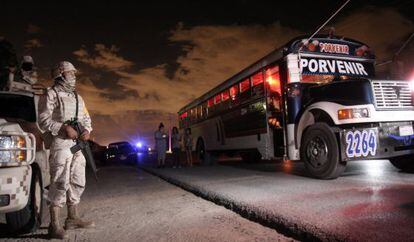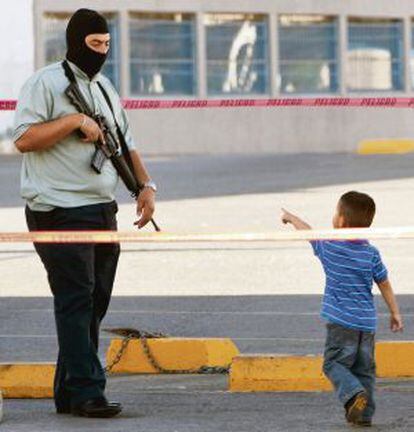Where 750 murders make for a good year
After a half-decade of gang warfare that left 7,000 people dead, Ciudad Juárez may be on the mend But the recent slaying of a family shows that the trauma will be hard to shake off

On Saturday, November 23, at around 10am on a bitterly cold morning in Ciudad Juárez, a group of university students gathered in one of the unpaved streets of the Mexican border city’s impoverished Colonia Morelos neighborhood. Most of them were women. They held hands and formed a circle and then released white balloons and held a minute’s silence for the eight members — including three infants — of the Romero Sánchez family, murdered here the previous Saturday. The only survivor was a three-month-old baby. The family, who were Jehovah’s Witnesses, had had their throats cut, one by one.
The students had been visiting Colonia Morelos for six months as part of an outreach program. Each Sunday they would meet in the house opposite where the killings took place. By a macabre coincidence, the Sunday that they had chosen to end the program, November 17, coincided with the discovery of the bodies.
The police arrived at 10.45am, after a call from a family friend who was concerned that nobody in the house had answered the phone. After entering the house and discovering the bodies, they cordoned off two blocks. The young women from the outreach program spent the next five hours being quizzed by police officers as possible witnesses to a crime that has taken the city, which sits across the Rio Grande from the Texan city of El Paso, back to the worst years of violence carried out by rival drug gangs. Between 2009 and 2011 Ciudad Juárez saw around 7,000 murders. Last year, the number of killings in this city of at least 1.3 million people fell to 751.
Colonia Morelos has been hit hard by the years of violence. Just taking a stroll around the area, a local resident points out dozens of spots were people have been killed. "We are paranoid," she says, signaling a patch of waste ground where she says a young man was publicly beheaded. Police patrols are now frequent, but there are also many luxury four-wheel drive vehicles with tinted windows prowling slowly around, presumably belonging to the drug gangs.
The family of Jehovah's Witnesses had their throats cut, one by one
War broke out in Ciudad Juárez at the end of 2007, although the city had already earned a grizzly global reputation due to the killings of hundreds of women in the preceding decade. The violence that erupted six years ago pitted the Sinaloa cartel, run by Mexico's most-powerful drug lord, Joaquín Guzman Loera, alias "El Chapo," against the Juárez cartel for control of the biggest entry point for narcotics into the United States. In 2008, as the violence spiraled out of control; the government sent in thousands of police and soldiers, but the death toll continued to rise.
Ciudad Juárez no longer holds the grim title of Mexico's murder capital: that dubious honor goes to Acapulco. The current death rate represents a substantial improvement, but needs to be seen in context. Spain, which has 47 million inhabitants, recorded 387 homicides in 2011. So far this year in Juárez, more than 300 people have been murdered.
Some say the city is returning to relative peace; others say the current decline in killings is part of a fragile truce that could end at any moment. Gustavo de la Rosa, a veteran human rights activist in the city, sees the situation as one of "post war," describing the inhabitants of Ciudad Juárez as "emotionally crippled." He says that the killing of the family of Jehovah's Witnesses reflects the post-traumatic stress that the city is suffering from collectively. "The terror survives, and it will take many, many years to overcome it," he says.
In September, the case of a woman calling herself Diana Cazadora, which translates as Diana Hunter, hit the headlines. She claimed responsibility in a series of statements released to the media for the killing of the drivers of two minibuses that transported the largely female workforce of the maquiladoras, the factories that produce export goods. She said the killings were in revenge for the murder of women in the city two decades ago, although the killings continue: a year ago, the police found the remains of 14 female teenagers scattered in the desert. They had been kidnapped and prostituted, and then finally murdered, when, as the men arrested for the killings told police, "they were no longer any use."
It's perhaps too early to know if the violence is really coming to an end. De la Rosa describes the situation as a "low-level war," comparing it to the competition that exists between the two most-famous soft drinks in the world. "The cartels were losing their soldiers; they ran out of money to recruit replacements; and the five years of war showed that the drugs trade would continue anyway, so there was no longer any reason to continue fighting. It's like Pepsi and Coca-Cola. They only stopped fighting when they realized that there was enough business for them both."
The cartels were running out of soldiers and money to recruit more"
As well as the cartels' realization that the war was achieving nothing, another key factor that contributed to the decline in violence was that civil society finally reacted. The turning point was the massacre in 2010 of 15 students at a birthday party in another outlying neighborhood, called Villas de Salvárcar. The public outcry led to the creation of the so-called Security Board, tasked with overseeing the authorities' strategy in dealing with the drug cartels. As a result, the armed forces and federal agents sent into the area were removed, the local police force was cleaned up and officers underwent training. State attorney Enrique Villareal described the change as: "Before, the police went round with a pistol stuck in their belt, and wearing gold chains; now they use a holster. They are respectable people."
A former police officer explains over a drink in a local bar that before the war between the cartels erupted, life for corrupt cops was easy. "It was a great time. There was a sense of comradeship, and everybody went home at the end of the day with money in their pockets from the fines we gave drivers." Traffic cops like him would overlook driving offenses in return for bribes, and then pay part of their income to their senior officer, but still take home 300 dollars a day.
"Those were the good days, but when the war started, we didn't even want to get out of our patrol cars, because you never knew who you were dealing with." He says that if he and his colleagues did stop a vehicle, the driver would pull out a cellphone, punch in a number, and then pass the phone. On the other end, the cop's boss would tell him to let the vehicle go. The traffic cop adds that most of the city's senior officers were in the pay of the cartels, and that working for the drug lords was not a matter of choice, but a matter of life and death: "You either worked for them, or they would fuck you up." Silver or lead.
The bar is full of young people singing along to the jukebox as it blasts out accordion-based norteña music, perhaps a sign that the city is beginning to return to normal. The former police officer remarks that a couple of years back, narcos were the only clientele to be found in a place like this.
State attorney Enrique Villareal says that Ciudad Juárez's progress should be compared to cities like Cali, in Colombia, or Palermo, in Sicily, which took at least a decade to recover from the damage caused by organized crime. De la Rosa warns that the current calm is relative, and that Ciudad Juárez could descend into violence again very easily. Until the end of the 1990s, drug traffickers' operations in the city depended on the interests of the main political parties, but by the beginning of the new century the power balance had shifted and organized crime was now running the show. With the worst of the violence between the cartels seemingly over, De la Rosa says that the power balance will likely shift back to the politicians. "Now it's time for a rest, but the risk is that if things don't improve quickly, within a decade we may well see the criminals taking control again."

De la Rosa says that while the local authorities have managed to stop the war, at least for the moment, they are not addressing "post-war" issues. He says the government of former President Felipe Calderón invested more than $500 million in the city to halt the bloodshed between 2010 and 2012. But the incoming administration of Enrique Peña Nieto decided this year to cancel a program providing educational grants to 20,000 young people.
Comparing the situation to Europe after World War II, De la Rosa accuses the new government of coming up with a "Marshall Plan in reverse." He believes that Ciudad Juárez needs emergency attention if it is to overcome its trauma, and that the young people of the poor outlying neighborhoods, like Colonia Morales, need help to rebuild their lives, men like 21-year-old Jesús Daniel Mendoza Hernández, known as "El Tomate," or Edgar Uriel Luján Guevara, age 31, both of whom were arrested for the killing of the Romero Sánchez family.
Luján Guevara appeared in a Juárez court on Friday, November 22, unwashed and unshaven in a gray track suit, and seemingly unaware of what was going on around him. The judge's job was to assess whether his arrest had been carried out legally. Shortly after the hearing began, Jesús Antonio Benzor, Luján's lawyer and an Evangelist minister, raised an objection, saying that the public prosecutor's office had only handed him the notes on the investigation a few minutes before. The judge called for a 90-minute recess.
The lawyer then left the courtroom with two assistants and headed for a roadside café where he perused the file while enjoying a hamburger. A few minutes later, a former police officer and acquaintance of the lawyer came into the café, and greeted him. "Well, here we are," said Benzor, "in a right mess over this kid. He is one of the murderers: well, supposed murderers, because they are scapegoats." On the table before him were photographs of the crime scene.
The lawyer asked his client to show the court the scars and bruises he had sustained
One of the assistants began to look over the images of the massacre.
"Whoever did this is not right in the head," he said.
The lawyer looked at the photos. "This guy is crazy. Who did this?"
A short while later, his friend the former police officer, said: "Well, you're really being put to the test on this one, old timer." The minister laughed.
The court hearing resumed shortly after 1pm. The defense lawyer asked his client to show the court the scars and bruises supposedly inflicted by police during his interrogation. Seeing the injuries, the judge ordered an internal investigation into the accusations, aware of the outcry that followed the Supreme Court's decision to release one of the men accused of the killing of the 15 students in 2010 after it was learned that he had made his confession after being tortured.
The defense lawyer says that his client was forced to make a second statement after he refused to confess to the killings, and that this was made under torture. In that statement he said that he and three other men, two of whom are still at large, committed the crime on Saturday, November 16 at 9pm. They broke into the house; there was a fight. Luján picked up a knife from the kitchen, killed the head of the family, then another adult, and then tied the rest up and killed them one by one with the same knife, first the women, and finally, the children.
The police say the head of the family owed Luján $100. He had allegedly agreed to pay the money in return for Luján mating his male pit bull terrier with a dog owned by the family.
Elders from Ciudad Juárez's Jehovah's Witness community said they never heard about Romero Sánchez's family having any problems. About 150 people gathered on November 20 at the Jehovah's Witnesses' Kingdom Hall in Ciudad Juárez for the funeral service of four members of the family.
"They, the family, were honorable people, dedicated to the church and to God. They would come to the church's meetings every Thursday and Sunday. This is something I can't explain. We are in shock," church elder Ismael Toribio told the congregation.
“Why did this happen?” church elder Daniel Sierra asked the assembled, before answering his own question: “Because Satan is the ruler of this land.”











































